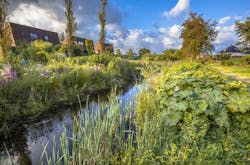A Call for Low Impact Development: the Time is Now
More than ever, there is an increasing need for the understanding and implementation of low impact development (LID) and green infrastructure (GI). From Phase I and II Municipal Separate Stormwater Sewer (MS4) managers to developers and consultants, we are working diligently to bring LID to the forefront. With a current fostering climate, combined with the backdrop of climate resiliency, sustainability, elevated corporate responsibility and environmental justice, there has never been a better time for LID. Through the push for increased implementation of LID, communities, developers and businesses can collaborate and work together to maximize the social, economic and environmental value of new and redevelopment projects.
The Emerging Reality
In our world, two things appear to be abundantly clear. First, urban hardscape by way of development is not decreasing. Second, there appears to be a climate change with increasing severity of drought or storms, which leads to stress on urban hydrology, and further exacerbates problems in the downstream portion of the watershed.
If you live in a metropolitan area, you have seen one, if not numerous, large-scale logistic-center type construction projects across your city or hometown. With this type of construction, the structures can be massive, sometimes encompassing millions of square feet. In Ontario, California, which is a regional transportation hub, a new project consists of the largest warehouse in California and potentially the U.S. This massive structure is a 5-story, 4.1 million square foot logistics center warehouse. Even 10 years ago, typical construction was not usually this immense. No longer are these construction projects for airport hangars, military operations, or large retail malls only.
These new developments often replace open space, including fields and permeable ground cover, significantly increasing runoff coefficients and downstream flow rates. The projects need to mimic former conditions and slow the hydrology down. LID and GI are flexible solutions that can be highly efficient in this regard when implemented correctly.
As we have seen, these large projects can have huge impacts on the watersheds. While some cities and local jurisdictions have urban hydromodification requirements, sometimes the requirements are not enough. State and local permitting agencies could further incentivize LID and GI projects by providing benefits to the developers and eventual benefits to the end-user. An example of these benefits could be a water feature, a winding swale or a retention basin for irrigation. Some developers are stepping up their game through increased social corporate responsibility and potential commitments to shareholders, communities or others.
Climate change science also predicts huge fluctuations in weather patterns. These include increasing swings, ranging from massive wet-weather events in the Midwest to severe droughts in the places in the West. In places like California, these climate swings are extreme. When effectively utilized, LID and GI can help. Stormwater can be one of the most valuable resources. LID Projects can capture, contain and reuse stormwater. On the other end of the spectrum and in dry areas, communities utilize stormwater through infiltration and injection wells for groundwater to recharge aquifers.
Commercial Development Impacts
While the terms LID and GI are becoming increasingly synonymous, they offer many benefits if implemented in the early stages of project life cycles. Project components such as swales and retention basins can be used during and after the construction project. Some larger-scale developments have many LID options, including implementing vegetated bioswales and grass buffer strips along paved areas. Direct parking lot and roof runoff through cut-curbs to swales connected to bioswales or potential rain harvest basins can help reduce discharge. Permeable pavers, grass/paver combined parking, and underground storage vaults can offer benefits in slowing down the hydrologic cycle.
Small commercial developments can also benefit from LID. In the case of small developments with multiple tenants, the owner or developer can create a stormwater plan for all the tenants, with a potential collective discharge to stormwater retention or detention basin. Such a plan allows the landlord to take a more collective approach and control for effective tenant stormwater management. In this scenario, the landlord has common control by potentially implementing a property-wide stormwater management plan. This cost could pass to the tenant, much the same way as other utilities, thereby having the tenants share the cost. The added benefit is having a single Stormwater Pollution Prevention Plan (SWPPP) is less expensive than multiple tenant SWPPPs – a differentiator in competitive urban commercial leases.
LID can be a Game Changer
Furthermore, in an increasingly complex regulatory waterscape, there are escalating discharge and receiving water limitations, effluent limits, or in the case of TMDLs, there is the possible prohibition of any potential contribution of the impairment pollutant of concern. LID can be an effective part of the best management practices (BMPs) implemented to meet the analytical benchmarks.
Now more than ever, it is increasingly important to consider LID early in the project life cycle. Doing so helps projects move successfully through environmental permitting and provides sustainability. LID is fairly new and can be engaging. People can envision, understand and see the culmination of benefits upfront. This kind of innovation may help secure early adopters, stakeholders, and people within the community to get some skin in the game.
There are myriad solution providers that provide structural LID and GI BMPs.
At no point in U.S. stormwater compliance history has there been so much research and development in the arena of potential solutions. These purveyors have tried and proven LID case studies and field-verified projects, and pilot studies that prove the efficacy of LID and GI implementation. There are also institutional bodies that can assist the potential developer and project. The Institute for Sustainable Infrastructure (ISI) has been in place since 2012, with its “Envision” Certification Program (think “LEED” for infrastructure), whereby the project can earn awards and national recognition through a 64-pt point verification framework, credit and award program. There are also entities like the “Low Impact Development Center” (LIDC), which is a funded non-profit 501(c)(3) national research organization that helps communities and developers focus on sustainable stormwater management solutions for cities and urban planning. This structured but diversified project guidance can help ensure that LID is woven into the project through its entirety by looking at long-term viability, sustainability, operations and maintenance.
The Future is Now
As stewards of the stormwater community, we constantly look at ways to foster, improve and implement LID and GI. There is no time like the present. With increasing modernization of our watersheds, and potential climate shifts, the questions should not be “why LID…but instead, why not LID”?
References
- United States Environmental Protection Agency (USEPA) Polluted Runoff: Nonpoint Source (NPS) Pollution;
- Urban Runoff: Low Impact Development (LID) https://www.epa.gov/nps/urban-runoff-low-impact-development
- California Stormwater Quality Association (CASQA) https://www.casqa.org/resources/california-lid-gi Low Impact Development Guidance
- The Green Infrastructure Foundation https://
Jonathan Meronek | Stormwater Compliance Practice Lead for the Southwest Business Unit of SCS Engineers
Jonathan Meronek, IGP-TOR, ENV-SP, QISP, CPESC, QSP/D, is stormwater compliance practice lead for the Southwest Business Unit of SCS Engineers. Meronek can be reached at [email protected].






